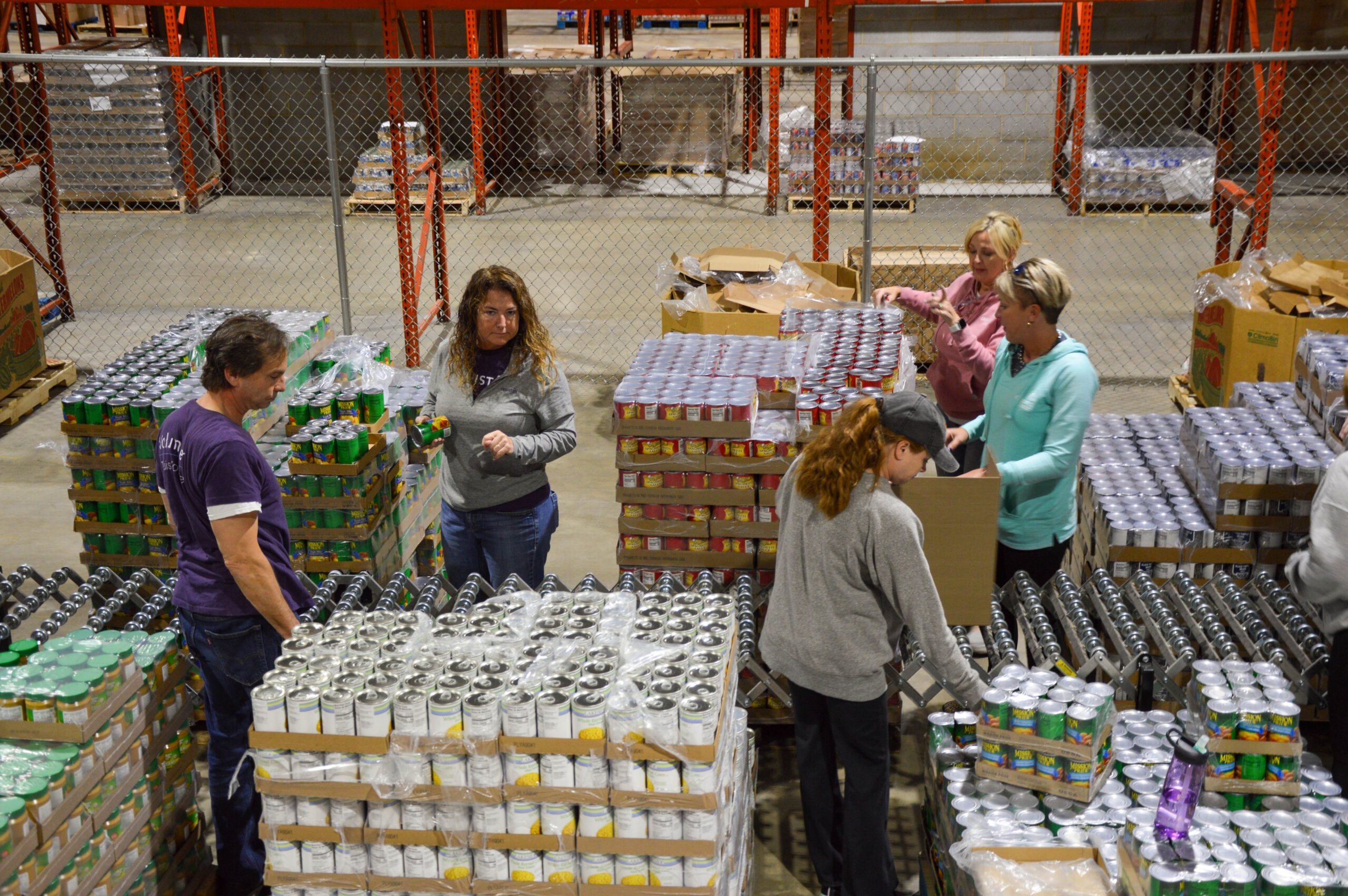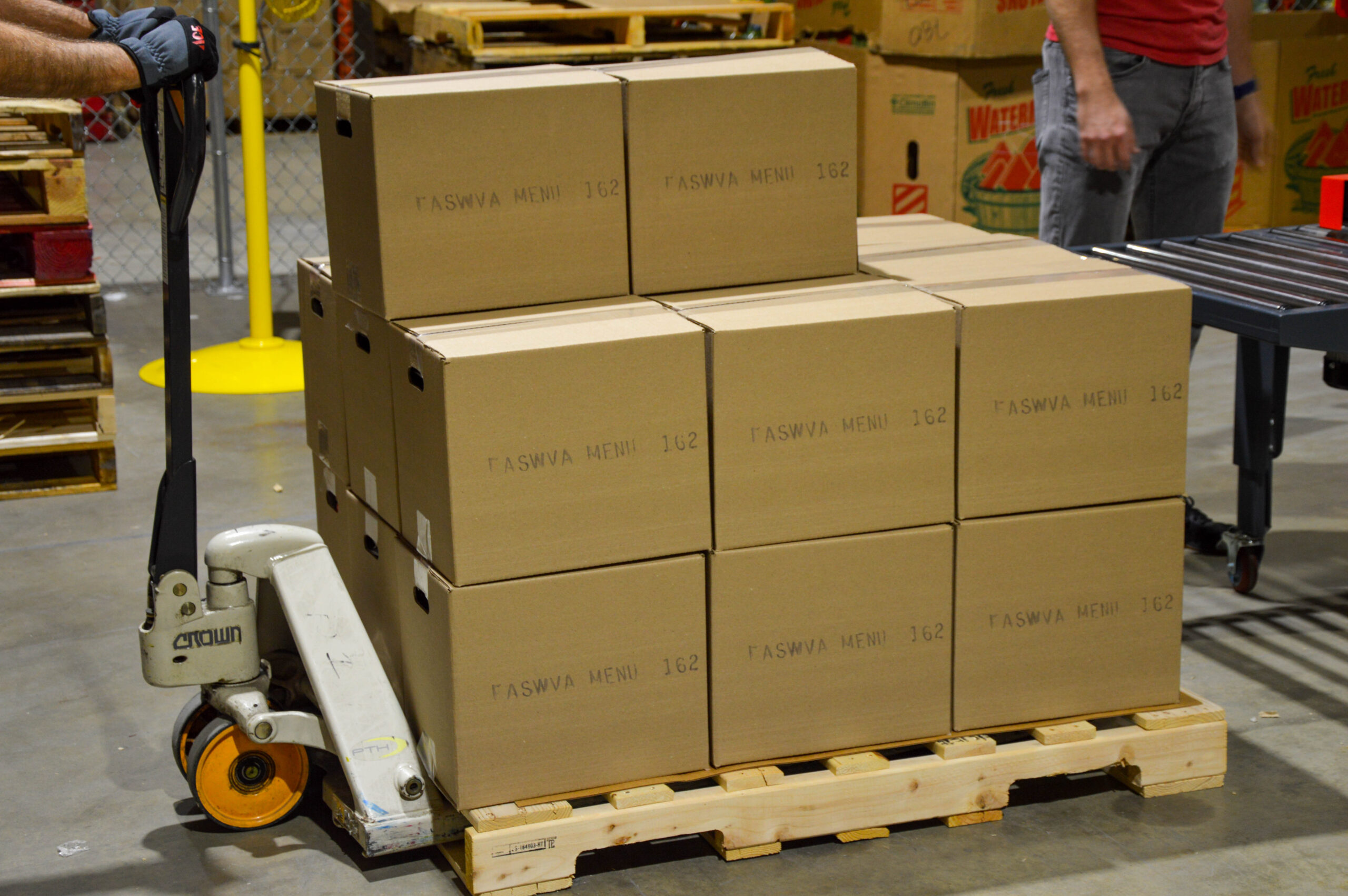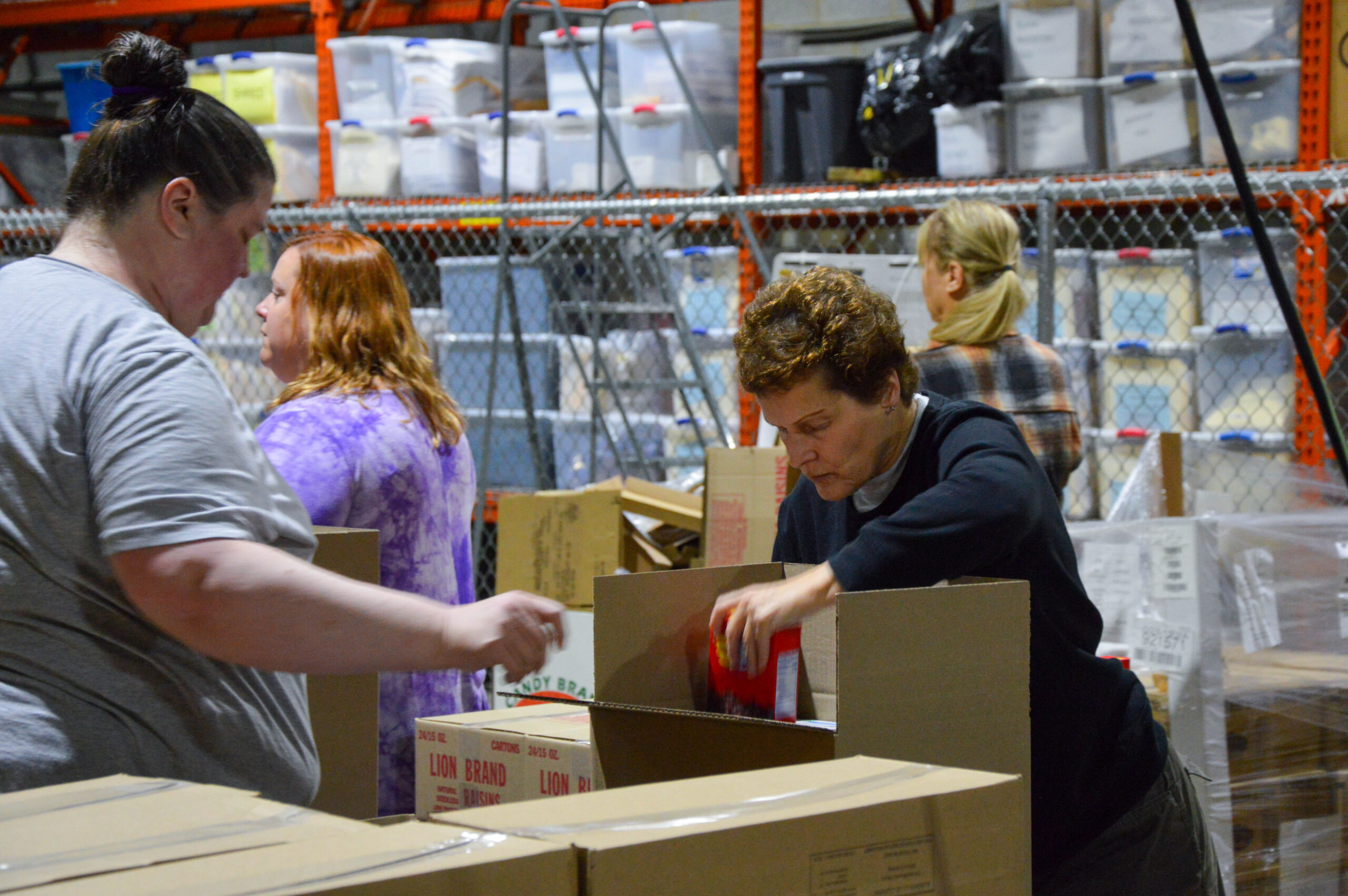
Combating food insecurity in our region
Lisa Archer
Into the cardboard box goes a can of peas. As it moves down a conveyor belt, many hands pass over it, adding boxed mashed potatoes, a jar of peanut butter, tinned salmon and pinto beans.
One in six children is hungry in southwest Virginia.
Elbow macaroni gently shakes out a two-step rhythm as it is tucked into place. The box moves down the belt.
One in eight residents in southwest Virginia faces hunger.
Beef stew, two 15-oz cans of sweet potatoes and a carton of shelf-stable milk are added as the box approaches the finish line, weighing in at a little over twenty pounds. It is taped shut, loaded onto a wooden pallet and moved via pallet jack to a 70,000 square foot warehouse, where it, along with 1,500 other boxes, will be transported via truck to an elderly housing community.
As we plan holiday dinners with heritage birds, gooey cheeses and cinnamon stick-adorned drinks, some of our neighbors are struggling.
165,000 residents are hungry.

For many of us, the holidays are glittered with memories of food. Licking the whipped cream off the whisk as a child, burning your first pie. Burning your second. Peeling potatoes with your mom in the kitchen. Hurriedly drying the dishes so you can join a board game or play with a new toy.
For some, though, the holidays mean memories they’d rather leave behind.
“Locating fresh, local food is harder. The cost of living always increases [utility bills]. People are more prone to illness. There are still seasonal jobs in our communities and so the challenges for food-insecure families and individuals increase during the winter months,” says Pamela Irvine, Director and CEO of Feeding Southwest Virginia (FSWVA), a non-profit that fights food insecurity across 26 counties in the region.
FSWVA, an affiliate of Feeding America, does more than just collect canned food. It is a multifaceted organization that serves its communities through a variety of programs, including providing food-insecure seniors with boxes of groceries. The majority of the work they do is with the help of volunteers and some 300 partner organizations. They source, transport and hand out food across 12,000 square miles out of two main hubs, one in Salem and one in Abington. They also educate the public, offer training programs to unemployed individuals, respond to emergencies and natural disasters, and advocate for policy change at the local and national level.

Southwest Virginia has the highest food insecurity rates among residents across the Commonwealth, especially in rural areas where industries such as tobacco farming and coal mining have slowly declined or altogether vanished. But the people are still there.
The region also has the highest child food insecurity in the state. And, while one would think getting food to children would be met with an outpouring of solutions, it’s not without its hurdles. FSWVA is often challenged by government restrictions. Specifically, all food given to children must be consumed on site and under observation in accordance with the Child Nutrition Reauthorization Bill (CNR). This restriction was lifted during COVID, allowing FSWVA to expand and instate 30 new programs targeting child food insecurity and nutrition. The Children Food Production Kitchen, located in Roanoke, prepares hot meals, and Cafe to Grow, a mobile meal truck, visits low-income communities to provide consistent meals for children. The programs developed during the pandemic meant that 1,800 additional children had access to healthy, fresh food.
“I’ve been volunteering for probably twenty years,” says Lori Hartwell. “I volunteer with Cafe to Grow a lot. It is fantastic. To see those kids, when they’re getting meals, to see that look on their face, they are so excited — it’s just amazing to be a part of.”

The new CNR is currently still in the process of being voted on and FSWVA is advocating for the removal of the congregate consumption clause.
“In our opinion it is discriminatory toward children in rural communities because they don’t have after-school programs, or they don’t have the Boys & Girls Club or access to some of the other great programs we have here in Roanoke,” Irvine says. Children living in rural areas also may not have transportation to places offering free meals.
Transportation is an issue across the board when looking at food insecurity. From children, to adults trying to get to work or the grocery store, to senior citizens who can no longer drive, FSWVA has to come up with innovative solutions of how to physically get the food that is donated or purchased into the hands of those who are hungry.
“We couldn’t do it without our volunteers,” says Randy Holden, Volunteer Coordinator. With such a large area to cover, it’s volunteers and partner organizations that enabled FSWVA to provide 18.5 million pounds of food last year to the region. When challenged with getting food to seniors, FSWVA partnered with in-home health care programs — those that already have systems in place and visit patients on a regular basis — to deliver groceries and meals.

“I buy groceries,” says Hartwell, who volunteers with her employer, TRUIST bank. “There’s two of us in the house and I see how much groceries have gone up. To be able to pack this box with staples and knowing they are on a limited income … The sheer amount we are packing, you know you’ve made a difference.”
A new initiative that helps determine exactly what kind of food goes to different areas was a result of Healthy America, a program started by Michelle Obama. Often food from the USDA or charitable food distributions comes from a “white food perspective” — it isn’t culinarily or culturally appropriate for everyone. Recognising the need to offer food that is both fresh, healthy, and local, but also of someone’s culture, led to more careful selection of the food provided to different communities. This was especially important during COVID when everyone was forced to stay home.
“During the pandemic, we actually had additional resources. Government commodities — we receive products through the VA Department of Agriculture that comes down through the Farm Bill funding, so we’re used to having those commodities, and of course there was additional funding during COVID. Now, we’ve had a lot of orders we’ve placed canceled — the supply chain is still very challenged. We’re down 41% in those commodities, so we’ve seen a drastic decrease, not just in food alone but for families who received assistance during COVID; now, they don’t have those resources available, so they are once again struggling. We’re seeing an uptick, probably 10-15% in some areas.”
That 10-15%, when appearing on a chart, may not seem like a lot, but when put in the perspective of 165,000 citizens — our neighbors — it should be a call to action.

We shouldn’t have food insecurity in our country. This isn’t a moral ethos, it is a fact. According to data compiled by Feeding America, Each year, 108 billion pounds of food is wasted in the United States. That equates to 130 billion meals and more than $408 billion in food discarded each year. Nearly 40% of all food in America is wasted. This is an appalling number. FSWVA and other food banks across the state are constantly attempting to procure food that would otherwise go to waste. Forging relationships with corporations such as Sheetz, Kroger and Food Lion helps combat waste in our communities, and there are farms and restaurants across the region, such as Cassell Farms and Turkey Knob Orchards, that donate their surplus.
But it can’t just be up to large corporations and farmers to lend a hand; we can all be a part of the solution.
This winter, we encourage you to find a way to help fight food insecurity in your community. Perhaps you are a producer with a surplus of product that can be donated. Perhaps you have five dollars to spare a week, which translates to twenty-five nutritional, fresh meals FSWVA can provide to food-insecure residents. Perhaps your place of worship or employment is looking for a way to further immerse themselves in their community.
“It was one of the things I wanted to do once I retired, ” says volunteer Glenn Bennett. “I thought that it would be a good thing. I worked all the time and I didn’t take the time to — I was not a part of the community. I worked, went home, slept, got up, went back to work. I did that six to seven days a week, and now, it’s my turn to give back.”
We can all help and it doesn’t have to take much. Please consider this:
For many, the holidays are a time of stress and insecurity. Access to regular meals is essential to the overall health and wellness of an individual. When a meal is missed, with it goes the chance for connection, stability, groundedness. A meal is so much more than nutrition; it is a part of our culture, our foundation. Food is integral to our identity. No one should go hungry.

Ways You Can Help
Donate
- Food: Canned goods, packaged items, fresh food still in its packaging.
- Time: Volunteer! Visit feedingswva.org to find volunteer opportunities in your area. You can pack kits, prep food, help with quality assurance, or hand out meals.
- Money: For every $1 donated, FSWVA can provide the equivalent of 5 healthy meals. Talk to your family about committing to donating $5/week or $50 a month, or start a fundraiser.
Educate:
Share your knowledge with your friends, family, coworkers. Encourage your employers to plan a company-wide volunteer day or food drive. Plan an event with your local place of worship.
Vote:
In order to end hunger, we need policies in place to support food-insecure individuals and halt food waste. Know your political figures at the national, state and local level. Ask them to do more to end hunger in our region.
This article first appeared in our Winter 2022 issue.
